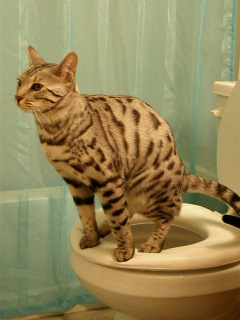The content listed below on the subject of How to Dispose of Cat Poop and Litter Without Plastic Bags is particularly enlightening. Try it and draw your own personal results.

Intro
As pet cat proprietors, it's important to bear in mind exactly how we throw away our feline close friends' waste. While it might appear practical to flush cat poop down the commode, this technique can have damaging repercussions for both the atmosphere and human health and wellness.
Environmental Impact
Flushing pet cat poop introduces dangerous virus and parasites into the water system, posing a substantial risk to aquatic ecological communities. These pollutants can negatively affect marine life and compromise water quality.
Health and wellness Risks
In addition to environmental problems, flushing pet cat waste can also present health dangers to human beings. Cat feces may have Toxoplasma gondii, a parasite that can trigger toxoplasmosis-- a possibly extreme illness, especially for expectant females and individuals with weakened immune systems.
Alternatives to Flushing
Luckily, there are more secure and more responsible methods to throw away pet cat poop. Take into consideration the adhering to choices:
1. Scoop and Dispose in Trash
One of the most usual approach of disposing of cat poop is to scoop it right into a biodegradable bag and toss it in the garbage. Make sure to utilize a devoted litter inside story and take care of the waste without delay.
2. Usage Biodegradable Litter
Choose biodegradable pet cat trash made from materials such as corn or wheat. These clutters are eco-friendly and can be securely thrown away in the trash.
3. Hide in the Yard
If you have a lawn, consider hiding cat waste in a marked area far from vegetable yards and water sources. Make sure to dig deep adequate to avoid contamination of groundwater.
4. Mount a Pet Waste Disposal System
Invest in a pet dog garbage disposal system particularly designed for feline waste. These systems make use of enzymes to break down the waste, decreasing smell and ecological impact.
Final thought
Liable pet ownership prolongs past providing food and shelter-- it additionally involves proper waste administration. By refraining from purging pet cat poop down the toilet and choosing alternate disposal techniques, we can lessen our ecological impact and secure human health and wellness.
Why Can’t I Flush Cat Poop?
It Spreads a Parasite
Cats are frequently infected with a parasite called toxoplasma gondii. The parasite causes an infection called toxoplasmosis. It is usually harmless to cats. The parasite only uses cat poop as a host for its eggs. Otherwise, the cat’s immune system usually keeps the infection at low enough levels to maintain its own health. But it does not stop the develop of eggs. These eggs are tiny and surprisingly tough. They may survive for a year before they begin to grow. But that’s the problem.
Our wastewater system is not designed to deal with toxoplasmosis eggs. Instead, most eggs will flush from your toilet into sewers and wastewater management plants. After the sewage is treated for many other harmful things in it, it is typically released into local rivers, lakes, or oceans. Here, the toxoplasmosis eggs can find new hosts, including starfish, crabs, otters, and many other wildlife. For many, this is a significant risk to their health. Toxoplasmosis can also end up infecting water sources that are important for agriculture, which means our deer, pigs, and sheep can get infected too.
Is There Risk to Humans?
There can be a risk to human life from flushing cat poop down the toilet. If you do so, the parasites from your cat’s poop can end up in shellfish, game animals, or livestock. If this meat is then served raw or undercooked, the people who eat it can get sick.
In fact, according to the CDC, 40 million people in the United States are infected with toxoplasma gondii. They get it from exposure to infected seafood, or from some kind of cat poop contamination, like drinking from a stream that is contaminated or touching anything that has come into contact with cat poop. That includes just cleaning a cat litter box.
Most people who get infected with these parasites will not develop any symptoms. However, for pregnant women or for those with compromised immune systems, the parasite can cause severe health problems.
How to Handle Cat Poop
The best way to handle cat poop is actually to clean the box more often. The eggs that the parasite sheds will not become active until one to five days after the cat poops. That means that if you clean daily, you’re much less likely to come into direct contact with infectious eggs.
That said, always dispose of cat poop in the garbage and not down the toilet. Wash your hands before and after you clean the litter box, and bring the bag of poop right outside to your garbage bins.
https://trenchlesssolutionsusa.com/why-cant-i-flush-cat-poop/

I'm certainly very excited about How to Dispose of Cat Poop and Litter Without Plastic Bags and I'm hoping you enjoyed reading the entire blog entry. Sharing is caring. You just don't know, you will be doing someone a favor. Thank you for your time spent reading it.
Additional Resources
Comments on “Hazards of Flushing Cat Poop Down Your Toilet - Avoid Potential Problems”